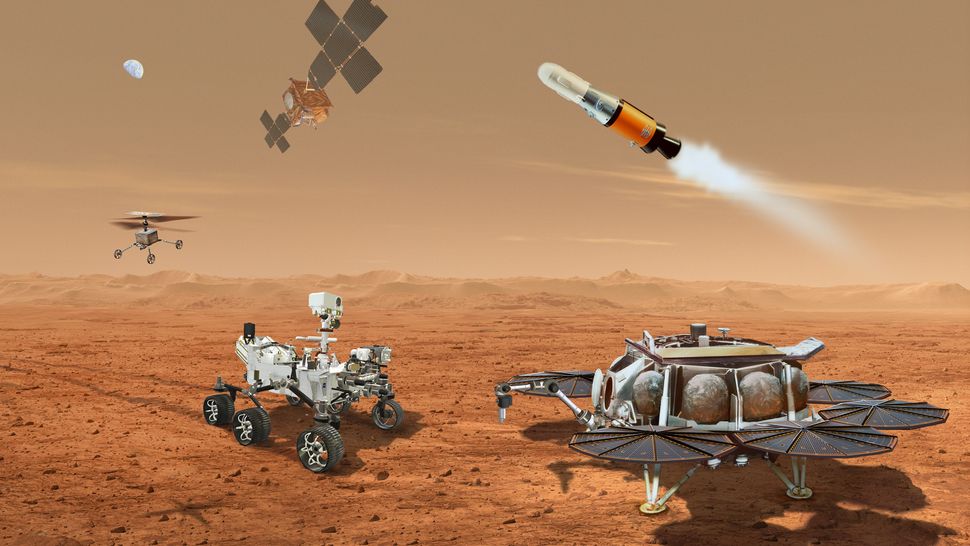The campaign to bring pristine
Martian samples to Earth will now include two mini helicopters.
Artist's illustration of the vehicles that will participate in the Mars sample return campaign organized by NASA and the European Space Agency. (Image credit: NASA/JPL-Caltech)
NASA officials involved with the Mars sample return (MSR)
effort announced yesterday (July 27) that they plan to redesign the mission,
abandoning a previous concept that called for a European Space Agency (ESA)
"fetch rover" that would touch down on its own lander.
NASA's Perseverance rover,
expected to still be active when a NASA MSR lander touches down in 2031, will
now be tasked with bringing the samples it is collecting and caching to a Mars
ascent vehicle. Failing that, however, two helicopters much like Ingenuity,
which landed with Perseverance last year, will be backup options to pick up the
caches themselves.
The helicopters will be similar
to Ingenuity in terms of size and mass, but with two key differences, NASA MSR
program manager Richard Cook told reporters during a briefing yesterday.
"There will be landing legs
that include, at the bottom of them, mobility wheels," Cook explained,
saying this new capability will allow the helicopters to "traverse across
the surface." A mini robotic-arm on each of the craft will allow the
drones to pick up the sample tubes Perseverance leaves behind, if need be.
If the helicopters are needed for
such work, they will land near a sample tube, roll over to pick it up, then fly
to a spot near the Mars ascent vehicle. After touchdown, the helicopters will
roll closer to the vehicle and drop the sample within reach of a newly
announced ESA-built transfer arm.
The redesign decision means that
no ESA rover will touch down on Mars in the near future. But the new
concept also may allow NASA and ESA to accomplish the ambitious sample return
effort with less cost and complication, according to the coalition.
"The engineer in me was
fascinated by the sample rover, because it's designed to travel much faster
than previous Mars rovers, probably about four or five times as quickly over
the surface," David Parker, director of ESA's human and robotic
exploration, told reporters yesterday.
Adding the rover, however, would
have entailed "a second launch, second lander and so forth," which
meant that removing the hardware from the manifest "makes a great deal of
programmatic sense," he said.
ESA is still building a rover
tasked with landing on Mars — a life-hunting robot named Rosalind
Franklin. That rover was supposed to launch this year on a Russian rocket,
but that plan fell through after Russia invaded Ukraine.
Rosalind Franklin is now expected to lift off no earlier than 2028.
"The engineering team has
been working at great speed to find an alternative approach for delivering
Rosalind Franklin rover to Mars," Parker said of the situation, saying different
options are under discussion. A special European council meeting in Paris in
November will allow member states to decide the best path forward, he added.
Comments
Post a Comment